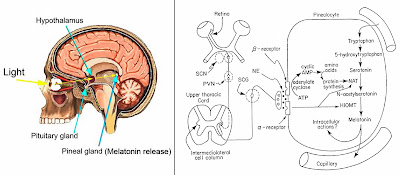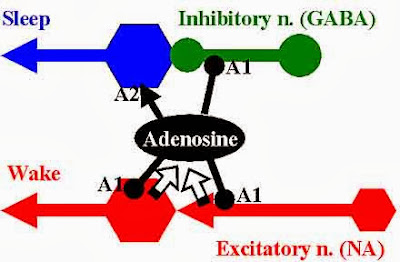Biology concepts – sleep induction, circadian cycle, narcolepsy, insomnia, anterior hypothalamus, neurotransmitters, cytokines, inflammation
Vivanco P, Studholme KM, & Morin LP (2013). Drugs that prevent mouse sleep also block light-induced locomotor suppression, circadian rhythm phase shifts and the drop in core temperature. Neuroscience, 254, 98-109 PMID: 24056197
Robey E, Dawson B, Halson S, Gregson W, King S, Goodman C, & Eastwood P (2013). Effect of evening postexercise cold water immersion on subsequent sleep. Medicine and science in sports and exercise, 45 (7), 1394-402 PMID: 23377833
Santos RV, Viana VA, Boscolo RA, Marques VG, Santana MG, Lira FS, Tufik S, & de Mello MT (2012). Moderate exercise training modulates cytokine profile and sleep in elderly people. Cytokine, 60 (3), 731-5 PMID: 22917967
España RA, McCormack SL, Mochizuki T, & Scammell TE (2007). Running promotes wakefulness and increases cataplexy in orexin knockout mice. Sleep, 30 (11), 1417-25 PMID: 18041476
Narcolepsy is a sleep disorder that affects 1 in 2000 Americans, and causes them to have episodes of extreme fatigue. They fall asleep at odd times, and are very hard to awaken. In addition, they may also suffer from wakeful dreams, and cataplexy, a condition similar to temporary paralysis. This can’t have instilled confidence in Harriet’s passengers, but she got the job done.
Narcolepsy is basically too much sleep induction, while insomnia is too little. Many people suffer from insomnia, and it can be brought on by many different conditions. Could your New Year’s resolution to start exercising end up helping both narcolepsy and insomnia. Let’s find out.
You wake up in the morning determined to wear yourself out on the treadmill sometime today. You’re going to run to exhaustion in the hopes that you will get a good night’s sleep as a result. Your doctor did say that working out would help you sleep – but is this what he meant? You run until you’re out of energy and then you sleep to refill the gas tank?
Exhaustion from exercise may play a role in inducing sleep, but there’s much more. Exercise helps in insomnia in the elderly according to some reports. Exercise also helps with narcolepsy in children and adults. But how does it help?
There are two competing hypotheses for exercise’s effects on sleep via your brain. They use two different sensors, but they both run through the brain. But first we need to know a little bit more about the sleep center of the brain to explain how exercise is affecting us.
Sleep was the subject of a series of posts a couple of years ago, starting with this post. But we didn’t talk much about the induction of sleep. Sleep used to be considered a passive process; you slept when the stimulatory inputs to the brain were diminished.
Orexin is one neurotransmitter with two names. It was discovered by two different groups at just about the same time, and each group named it something different. Scientists haven’t decided yet which name to go with, so they use both.
There are only 10,000-20,000 neurons which produce orexin/hypocretin, so damage to any part of this area of the brain could induce narcolepsy. This may have been what happened to Harriet Tubman after her master hit her in the head when she was 12 years old. On the other hand, the brain trauma may have resulted in too much VLPO and AH sleep promotion. Either way, she was a professional napper.
So stimulating the POAH and the VLPO lead to sleep at least in part by inhibiting the production of orexin/hypocretin. But what stimulates the POAH and VLPO? Knowing nature as you do, you can bet there are several pathways. One way is certainly routed through the circadian clock. We have talked before about the sleep cycle controlled by the clock.
Temperature hypothesis:
The temperature hypothesis for sleep induction states that a one-degree decrease in your core temperature is enough to trigger sleep induction pathways on the brain. How could these two factors be linked? Well, the temperature sensing and regulating centers of your brain are located in the anterior hypothalamus, right next to the sleep centers (POAH and VLPO).
Reducing temperature is a way of saving energy by the body; this is probably an evolutionary holdover from when calories were hard to come by. Decreasing temperature signaled the brain that less activity was going on, so the body induced sleep to further reduce temperature and save energy for the next day.
It so happens that activity also decreases when the sun goes down, or at least it did before Thomas Edison and the electric light. This strengthened the link between temperature and the circadian sleep/wake cycle. To illustrate this point, a 2013 study measured the effects of drugs on both the circadian patterns and temperature. Drugs that altered the light responses in the SCN, including caffeine, also altered core temperature.
That then brings up the question of how exercise helps you go to sleep just by messing with your temperature. You exercise - you get hot - the blood vessels in your skin dilate and you sweat to dissipate some of the heat. But sweating isn’t 100% effective, your core temperature does go up. After you finish exercising, your temperature goes down slowly over time.
This decrease in temperature is the cue for your body to begin sleep. Your anterior hypothalamic temperature-regulating center can’t tell the difference between this decrease and the decrease brought about by circadian rhythms. So you may get sleepy a few hours after exercising, as your temperature comes down.
So, is right before bed the best time to exercise? Nope. Exercising stimulates your brain and cardiovascular system as well as raises your temperature. Trying to sleep right after exercise will probably be harder than normal, just because you are firing on all cylinders in your brain and heart.
The best time to exercise to help you get to sleep is about five hours or so before you plan on retiring for the evening. Your temperature goes up while exercising, and then will start to drop just about the same time you are ready for bed. This will reinforce the circadian cycles and give you the best shot at good sleep.
One 2013 study looked at exercise time, temperature manipulation and sleep patterns in professional and highly trained amateur cyclists. The results showed that evening exercise had no affect on sleep patterns, even if combined with a cold water dunk after the cycling routine (brrr!). Neither exercise nor exercise + decreasing temperature brought on a decreased time to spontaneous sleep. So – they sleep well because they wear themselves out each day.
Cytokine hypothesis:
The other system that may be important for inducing sleep after exercise is the immune system. Cytokinesare chemical messages that influence many different parts of the immune system. They come into play when you have an infection, or cancer, or allergy; basically any insult to your system.
There are many different cytokines, and they perform many different jobs. Certain cytokines can even mediate opposing pathways, depending on the stimulus that starts their production and release. Some promote inflammation (pro-inflammatory) when one specific injury is sense, but inhibit inflammation (anti-inflammatory) if a different insult occurs.
Exercise can be seen as a stress to the body. It can injure muscles; in fact, that's how you build muscle. You tear them down a bit through work, and they grow back bigger and stronger. This is an insult that results in cytokine production and release into the bloodstream. But the more you train, the less of an insult your body registers.
IL-1beta, TNF-alpha and IL-10 are cytokines that have been associated with sleep induction. Plasma levels of IL-1beta are highest just as sleep is induced; this is one of the things controlled by the circadian system. But prolonged IL-1beta or TNF-alpha results in short sleep, and it is easy to wake you up.
A 2012 study showed that in the elderly with insomnia, moderate training over months resulted in lower IL-1beta, lower TNF-a, and higher IL-10. These were also associated with better sleep patterns.
The neurons of the sleep center are sensitive to pro-inflammatory cytokines; inflammation signals disrupt the restful sleep patterns we are looking for. This involves the pro-inflammatory stimulation of cortisol, the stress hormone, so exercise’s help in sleep may be again related to a reduction of stress effects. This is a complicated system, but the take home message is, more exercise results in less pro-inflammatory cytokine action on the brain.
Chronic fatigue is also linked to high levels of pro-inflammatory cytokines in the brain that are unhooked from the decrease induced by training for some time. In the opposite direction, narcolepsy is aided by exercise, perhaps by reducing the cytokines that would inhibit orexin/hypocretin domination (wakefulness) in the anterior hypothalamus.
A 2007 study showed that in mice that don’t make orexin/hypocretin (have narcoplepsy), running on the wheel helped them stay awake more during the day. Of course, it also led to more episodes of cataplexy, so the story is not complete.
Next week, another brain effect of exercise – it can actually build your brain and make you smarter. Start running before that next AP quiz.
Vivanco P, Studholme KM, & Morin LP (2013). Drugs that prevent mouse sleep also block light-induced locomotor suppression, circadian rhythm phase shifts and the drop in core temperature. Neuroscience, 254, 98-109 PMID: 24056197
For more information or classroom activities, see:
Exercise and sleep –
Narcolepsy –
Orexin/hypocretin –
VLPO and sleep –





